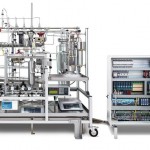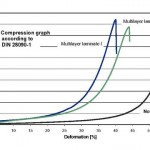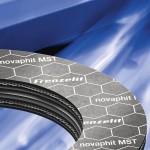Novaphit MST is a graphite gasket material with better sealing properties and greater adaptability that is suitable for applications involving very high pres-sure levels combined with high temperatures. It is used, for example, in a fixed bed reactor for testing heterogeneous catalysts, in which it does its job reliably at a maximum pressure of 200 bar and a maximum temperature of +500 °C.
Marco Schildknecht
In order to increase efficiency and performance, process temperature and pressure levels are meanwhile being raised higher and higher. This is also true of the semi-automatic system from ILS Integrated Lab Solutions with a fixed bed reactor for testing heterogeneous catalysts. With operating specifications combining 200 bar with +500 °C, new dimensions are being entered here, not only in the decomposition of organic substances but also in the demands made on the reactor sealing. The ILS design was built by Swiss manufacturer Premex Reactor and has been in continuous, successful operation since August 2009 with a flat gasket material made from graphite. The design of the reactor itself involves a flat gasket connection at both the top and bottom, which is established via a G2” screw joint. The high-temperature steel used is the primary reason why as flexible a gasket as possible is required, in order to avoid damage to the sealing surfaces when product and/or test changes are made. If, therefore, a decision is taken against a metal gasket solution, the application temperature needed clearly points to a graph-ite gasket.
In the case of high-quality gaskets made from expanded graphite, an appropriate oxidation inhibitor is employed, permitting use at temperatures up to a maximum of about +550 °C. Experience has shown that internal pressure levels of up to 250 bar can only be covered reliably by special, multilayer graphite gaskets. It is standard practice to advise against using the latter when maximum temperature coincides with maximum pressure. However, this is exactly what is required in this particular case. The necessary safety and reliability can only be guaranteed with a technically sophisticated gasket material. Novaphit MST, the high-performance graphite gasket developed by Frenzelit, meets these extreme requirements and performs convincingly. It is even more impressive when the gasket’s unfavourable geometry (35.5 x 50.5 x 2.0 mm) is considered.
High gasket requirements
What specific properties does Novaphit MST have that enable it to perform better and thus also be suitable for extreme requirements? The answers to this question read like a list of the specifications for the gasket’s development:
- Increased sealing properties, primarily with respect to very small, gaseous media
- Increased maximum tolerable surface pressure level, so that high pressure can be withstood
- Better adaptability to gasket surface un-evenness compared with other multilayer products
- Safe handling, simple processability
One example: the adaptability of the gasket depends to a large extent on the basic density of the graphite used. The same applies to its sealing performance, since most of the leakage encountered with graphite gaskets is via the cross-section. Lower graphite density means better adaptability, but also a higher degree of microporosity and thus greater leakage – and vice-versa. The situation is similar where general adaptability and the maximum tolerable surface pres-sure level are concerned (the latter in turn being very important for withstanding high internal pressure). The higher the thickness of a graphite layer, the better the adaptability will be, but the gasket is de-stroyed at lower surface pressure levels. If the layer thicknesses are made arbitrarily small, even extremely high surface pres-sure levels can no longer destroy the graph-ite, although it is practically impossible to compensate for gasket surface unevenness.
The conflicts between the different objectives have been solved in exemplary fashion by Novaphit MST. A 3.0 mm thick gasket consists of a total of 11 layers. Each graphite layer has a thickness of 0.5 mm. The individual layers are separated by acid and heat-resistant stainless steel inserts (1.4404/AISI 316L). Whereas the inner inserts are made from flat metal, all the outer inserts are made from expanded metal.
In contrast to flat metal, expanded metal does not act as a complete separating layer; instead of this, it has a positive impact on partial adaptability to flange unevenness. A new dimension is entered where the maximum possible surface pressure level is concerned, as the diagram shows. The thickness of the gasket decreases by about 40 % at a surface pressure level of only 10 Mpa. This means that even flange dam-age outside standard specifications and/or dimensional and layer tolerances can be compensated perfectly. Just as impressive: a crash point corresponding to that of the other two standard multilayer laminates tested was not detectable even on the most modern and powerful gasket testing facilities from Amtec.
These distinctive cold creep properties are achieved owing to the lower basic graphite density. The truly revolutionary advance made in the development of Novaphit MST is, however, its low leakage concurring with excellent adaptability and maximum possible surface pressure. The material satisfies the latest requirements, e.g. the German fugitive emission regulation TA Luft and the VDI directive 2290 that will be coming into force soon.
Specially impregnated
The secret behind this combination of sealing performance, resistance to high pres-sure and temperature levels and adaptability is the huge improvement in the graphite impregnation. It goes without saying that any contamination of the graphite needs to be avoided. Particularly in view of this, no substances should be added that have a negative impact on the mechanical properties under the influence of temperature, for example. This is, however, exactly the way conventional impregnation works to compensate for graphite microporosity.
The amount added therefore needs to be kept very low, as a result of which leakage inhibition has to be low as well. Frenzelit is adopting new approaches with the impregnation technology for Novaphit MST and Novaphit SSTCTA-L by merely encapsulating the microporosity. Small amounts of the active substance, which is harmless to health, therefore improve sealing performance without having any negative effects on other important properties.
Online-Info www.cpp-net.com/2310404
Share:









